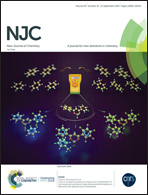Distinguishing external and internal coke depositions on micron-sized HZSM-5 via catalyst-assisted temperature-programmed oxidation†
Abstract
Coke deposition on zeolites is the major cause for catalyst deactivation in many reactions. Understanding the coking behavior and characterizing coke deposition certainly help in designing an advanced coke-resistant catalyst. Compared with the amount and properties of coke in the spent catalyst, it is still difficult to differentiate the coke location on a zeolite. Herein, we built a simple but effective way to distinguish external and internal coke depositions on a metal-free and microsized HZSM-5 zeolite by the post-addition of Cr species onto the external surface of zeolite crystals and then employing traditional temperature-programmed oxidation (O2-TPO), which can be defined as catalyst-assisted TPO or CatA-TPO. The basic idea was that the added metal oxides (like Cr2O3) greatly lowered the coke-burning temperature in O2 and on the other hand only promoted the catalytic oxidization of the external coke on zeolite, but little influenced the burning behavior of the coke formed in zeolite channels, because the post-added metal oxides located only on the external surface of coked zeolite sample.



 Please wait while we load your content...
Please wait while we load your content...